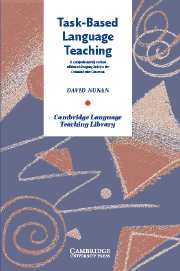Book contents
- Frontmatter
- Contents
- Acknowledgements
- Introduction
- Chapter 1 What is task-based language teaching?
- Chapter 2 A framework for task-based language teaching
- Chapter 3 Task components
- Chapter 4 An empirical basis for task-based language teaching
- Chapter 5 Focus on form in task-based language teaching
- Chapter 6 Grading, sequencing and integrating tasks
- Chapter 7 Assessing task-based language teaching
- Chapter 8 Tasks and teacher development
- Appendix A Approaches and methods – an overview
- Appendix B A unit of work based on the six-step procedure presented in Chapter 2
- Appendix C A unit of work based on the task/exercise typology in Chapter 5
- Appendix D Graded activities for the four macroskills
- Appendix E Common reference levels: self-assessment grid
- Glossary
- Index
Chapter 4 - An empirical basis for task-based language teaching
Published online by Cambridge University Press: 16 February 2010
- Frontmatter
- Contents
- Acknowledgements
- Introduction
- Chapter 1 What is task-based language teaching?
- Chapter 2 A framework for task-based language teaching
- Chapter 3 Task components
- Chapter 4 An empirical basis for task-based language teaching
- Chapter 5 Focus on form in task-based language teaching
- Chapter 6 Grading, sequencing and integrating tasks
- Chapter 7 Assessing task-based language teaching
- Chapter 8 Tasks and teacher development
- Appendix A Approaches and methods – an overview
- Appendix B A unit of work based on the six-step procedure presented in Chapter 2
- Appendix C A unit of work based on the task/exercise typology in Chapter 5
- Appendix D Graded activities for the four macroskills
- Appendix E Common reference levels: self-assessment grid
- Glossary
- Index
Summary
Introduction and overview
One of the things that differentiates task-based language teaching from earlier methodological proposals is that it is supported by a rich and growing research agenda. Some of the more idiosyncratic approaches of the 1960s and 1970s may have attracted many devotees during the height of their popularity. However, little, if any, empirical research was conducted into their effectiveness. A possible exception was audiolingualism, although research carried out into the effectiveness of this approach in comparison with other methods was largely inconclusive (for a review see Bailey 1999; Nunan 2003).
In this chapter, I will focus principally on psycholinguistically oriented research, looking in particular at two influential hypotheses: the input hypothesis and the output hypothesis. I will also examine the important issue of task difficulty, exploring the different factors that make one task more difficult than another.
Chapter 5 will also review research, but will focus exclusively on research related to the place of a focus on form in task-based language teaching. It will thus be more circumscribed than the present chapter.
Early psycholinguistic models
Around the mid-1980s, a number of controversial hypotheses of language acquisition were proposed by Stephen Krashen. Although they came under concerted attack almost from the moment they were first published, to this day they remain popular, widely cited and influential, particularly in North America. They have also had a major influence on task-based language teaching, and for this reason deserve some attention.
Krashen (1981, 1982) based his hypotheses on a series of studies known as the ‘morpheme order studies’ (Dulay and Burt 1973, 1974).
- Type
- Chapter
- Information
- Task-Based Language Teaching , pp. 76 - 92Publisher: Cambridge University PressPrint publication year: 2004



